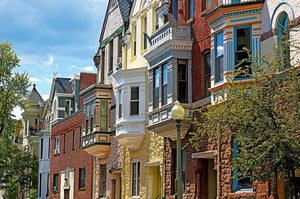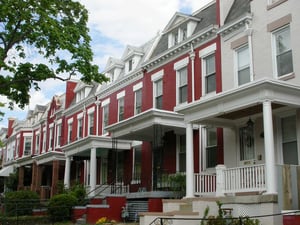Spring is a wonderful season to take a walking tour through DC neighborhoods. I recently reminisced about a walk my grandfather and I took around the Dupont Circle area of DC when I was a graduate student. We took in some of the architectural marvels of the neighborhood, which includes many examples from Queen Anne, Beaux-Arts, Richardsonian Romanesque, Edwardian, and Italianate-style architecture.
Our plan was to find and record examples of window design — transoms, dormers, and various bay styles. My grandfather is a retired architect, and I was a student. He has taught me more about design than most university professors because he has lived in DC most of his life.

We also looked for roof designs such as mansard, gabled, flat, turret, overhangs, and Italianate-style bracketed eaves. Although mansard roofs are typically present on French Second Empire row houses, we wanted to see other examples of how the roof style was used.
DC rowhomes are perfect places to find examples of various specimens of architectural style, as you might see six or eight different style elements in one block.
A City Filled with Architectural Eye-Candy
There are more than a few National Historic Landmarks in the Dupont Circle neighborhood. Although the circle bears the name of Admiral Dupont, a hero from the Mexican–American War who captured San Diego, the neighborhood’s history goes back further, to 1871 when the Army’s Corps of Engineers put in what was then called the Pacific Circle.
As we walked along the grand neighborhood, my grandfather pointed out a rowhome with Romanesque-style stone steps, a Georgian front door topped with a semi-circular fanlight. He pointed out how symmetrical everything is, even though it might contain style elements from different periods.
Looking up at the building, I saw a circular window with the bricks surrounding it, forming the circle, then a semi-circular bay dormer, and a slate roof with turret caps that topped this wonderful brick home.
My grandfather pointed out the Hunter Green door on the home. It had a brass lion’s head knocker, and he joked that it could win a no-bell prize. There was also a brass door pull and mail slot. Above the door there was a stained-glass fanlight window, also Hunter Green, with shining brass spokes in the shape of a half wheel.
The Importance of Porches, Stoops & Front Steps
Renowned builder and developer Harry Wardman (1869-1938), famously included covered porches on most of the DC rowhomes and residential properties he built. Perhaps, because he understood the need for homeowners to relax on the porch in the summer, communicate with the neighbors, and watch the comings and goings without peering through the window.
 One Petworth rowhouse resident wrote, “The porches [were] a big part of growing up in Petworth. On my block, there had to be 15 or 20 kids, and you’d come home from school, get on the porch, and look down the block, and you could see this long row of porches, and you’d see everybody coming out of their house. The porches made you get to know your neighbors. They made it a neighborhood.”
One Petworth rowhouse resident wrote, “The porches [were] a big part of growing up in Petworth. On my block, there had to be 15 or 20 kids, and you’d come home from school, get on the porch, and look down the block, and you could see this long row of porches, and you’d see everybody coming out of their house. The porches made you get to know your neighbors. They made it a neighborhood.”
Many architects and builders copied Wardman’s front-porch style across the city. The front porch was a spot to socialize with neighbors and friends. Perhaps, more essential for sleeping in the summer were the screened backyard porches. Many first-floor residents took their cooking on the back porch.
Tour Complete
My grandfather and I sat down on his front porch to go over what we saw on our historical walk, and I jotted down some quick notes, which I transcribed later for my thesis. It turns out rowhouses are an excellent source for architectural design elements, as he taught me.
Author Christina Wilson talks more about decorative front doors in her pre-Christmas article in 2020, Seasonal Décor for Historic Entryways. Many DC historic rowhomes have fashionable front doors with extravagant hardware and accessories, that shine with seasonal decoration. And to learn more about rowhomes in other DC neighborhoods, see this resource celebrating Wardman homes and buildings in DC, and this on researching the history of Capitol Hill rowhouses.





